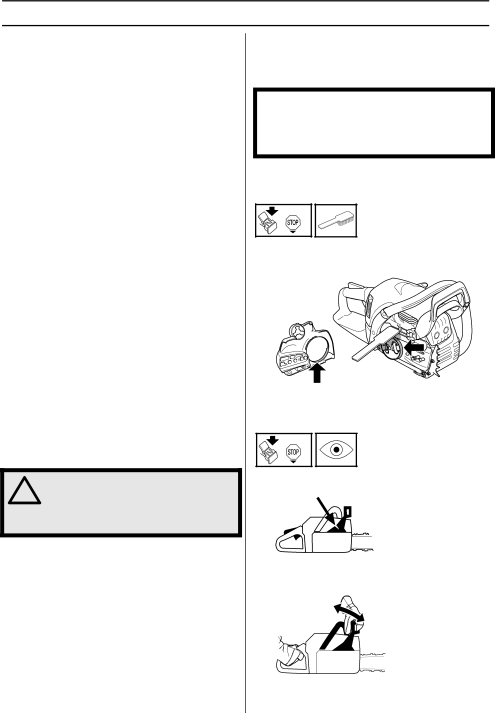
MAINTENANCE
General
The user must only carry out the maintenance and service work described in this manual. More extensive work must be carried out by an authorised service workshop.
Carburetor adjustment
Your Jonsered product has been designed and manufactured to specifications that reduce harmful exhaust fumes.
Function
•The carburetor governs the engine’s speed via the throttle control. Air and fuel are mixed in the carburetor. The air/fuel mixture is adjustable. Correct adjustment is essential to get the best performance from the machine.
•The
Basic settings and running in
The basic carburetor settings are adjusted during testing at the factory. Fine adjustment should be carried out by a skilled technician.
Rec. idle speed: See the Technical data section.
Fine adjustment of the idling speed T
Adjust the idle speed with the
WARNING! Contact your servicing
! dealer, if the idle speed setting cannot be adjusted so that the chain stops at idle. Do not use the chain saw until it has been properly adjusted or repaired.
Correctly adjusted carburetor
When the carburetor is correctly adjusted the machine accelerates without hesitation and the machine
Checking, maintaining and servicing chain saw safety equipment
Note! All servicing and repair work on the machine requires special training. This is especially true of the machine′s safety equipment. If your machine fails any of the checks described below we recommend you to contact our servicing dealer.
Chain brake and front hand guard
Checking brake band wear
Brush off any wood dust, resin and dirt from the chain brake and clutch drum. Dirt and wear can impair operation of the brake.
Regularly check that the brake band is at least 0.024 inch (0.6 mm) thick at its thinnest point.
Checking the front hand guard
Make sure the front hand guard is not damaged and that there are no visible defects such as cracks.
Move the front hand guard forwards and back to make sure it moves freely and that it is securely anchored to the clutch cover.
English – 31